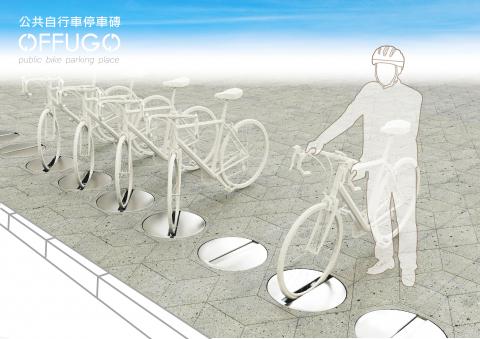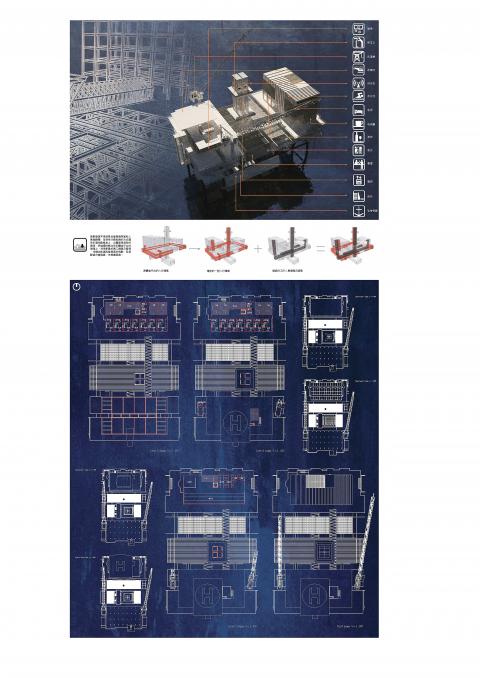Three college seniors have created an innovative bike lock meant to provide more room on Taipei’s congested sidewalks. Offugo (公共自行車停車磚) is an aluminum alloy plate that fits like a manhole cover into the ground and works by pinning a tire to a retractable spine. It doesn’t look like much, but that’s the main attraction.
“Think about YouBike, which uses a special rack on the sidewalk,” said co-inventor Cin Siou-huei (秦秀惠) about Taipei City’s bike rental system. “Take away the bike and that rack is still there, taking up space in a space-poor city.”
“Our lock isn’t a visual or literal block to pedestrians,” she said. “Also, in the end it would be cheaper to switch to this system from the YouBike rack, since all you really need is the disc.”

Photo Courtesy of Shu-te University
Last week, the disc was a big winner at the Young Designers’ Exhibition (YODEX, 新一代設計展) in Taipei, where graduating college seniors from across Taiwan vied for a handful of medals. Offugo beat out 1,160 entries for the gold in Product Design (產品設計類) and a silver in the space solutions category (空間設計類), which received 320 entries.
Chou Jing-heng (周敬恆) took a gold medal in the space solutions category with Boundary into the Plan (邊界突入計畫), a scale model based on an abandoned oil drilling platform in the East China Sea. Chou has done major remodeling, which includes knocking out walls and adding a floor with a gambling casino and resort.
Chou even has a colorful story to go with it. The upstairs entertainment zone is for Chinese tourists and the downstairs chambers are for Taiwanese, who service the resort. The space encourages an economic interaction that could allow Taiwan to “elude domination” by its neighbor across the Strait, according to Chou, 22, who is a passionate observer of current events.

Photo Courtesy of Young Designers’ Exhibition
“Hypothetically, if Taiwan is taken over by China, at least we would still have this place. From here, we can slowly take back the island chains, so long as the Taiwanese spirit is there,” he said.
Meanwhile, two students who took a silver medal in the visual communication design category also had tourists in mind, though they were thinking more in the present.
“In bookstores today you can find good guidebooks on Taiwan, but they introduce sites to visit and places to eat. There aren’t many about daily perplexities that foreigners encounter,” said Hazel Tsao (曹乃云).

Photo Courtesy of Chou Jing-heng
Tsao and schoolmate Chen Hsiao-tzu (陳孝慈) won a silver medal for Taiwanese Manual, three books of advice customized for Japanese, American and Chinese visitors. For example, Japanese tourists are warned that tea sold at convenience stores are usually sweetened — “Teas in Japanese stores are not,” Tsao said, citing her interviews with Japanese subjects — while guests from the US are advised that braziers are not garbage disposals. All the advice is presented together on the page, so that the Japanese reader can see all the questions of Americans and Chinese.
“At first, we thought about separating the manuals by language, but then we thought that if we combined all the information, each nationality can see how other people respond to Taiwan and the manuals can be a point of communion for first-time visitors,” said Tsao.
Other YODEX winners included an origami set by Shu-Te University (樹德科技) — original foldable designs based on Toroko Gorge wildlife — which picked up a silver each from the product and visual communication categories. Some of this origami is quite a challenge and designers said they want to encourage parent-child interaction.
The Missing Piece (缺角的圓), which took a gold medal in the digital multimedia design category (數位多媒體設計), does too. It’s a stop-motion film and each of its 220 seconds uses eight to 24 frames that are photographed one at a time, after tiny adjustments to photographed subjects are made by hand. The star of the show is a miniature doll with movable joints and over a dozen detachable faces that were hand molded, etched and painted. Most of the faces are gloomy.
“She knows her parents won’t be there for her birthday, though she remains hopeful,” said designer Chiu Hung-chieh (邱虹潔). “The film ends with the ring of a door bell, which leaves the issue open-ended. It could be the parents.”
“The film is actually based on my personal experience... My parents watched it and said that I exaggerated, but my sister watched it and cried,” Chiu said. “To an extent, my team members also experienced something similar.”
Stop-motion animation is a visibly unfinished and childlike medium that appeals to adults, her team’s intended audience.
“I think that parents in Taiwan are working hard to earn money to give their children better material circumstances, and they leave their children to nannies. What I’m trying to say to them is that a home needs its people,” she said.

Most heroes are remembered for the battles they fought. Taiwan’s Black Bat Squadron is remembered for flying into Chinese airspace 838 times between 1953 and 1967, and for the 148 men whose sacrifice bought the intelligence that kept Taiwan secure. Two-thirds of the squadron died carrying out missions most people wouldn’t learn about for another 40 years. The squadron lost 15 aircraft and 148 crew members over those 14 years, making it the deadliest unit in Taiwan’s military history by casualty rate. They flew at night, often at low altitudes, straight into some of the most heavily defended airspace in Asia.

Many people in Taiwan first learned about universal basic income (UBI) — the idea that the government should provide regular, no-strings-attached payments to each citizen — in 2019. While seeking the Democratic nomination for the 2020 US presidential election, Andrew Yang, a politician of Taiwanese descent, said that, if elected, he’d institute a UBI of US$1,000 per month to “get the economic boot off of people’s throats, allowing them to lift their heads up, breathe, and get excited for the future.” His campaign petered out, but the concept of UBI hasn’t gone away. Throughout the industrialized world, there are fears that

Like much in the world today, theater has experienced major disruptions over the six years since COVID-19. The pandemic, the war in Ukraine and social media have created a new normal of geopolitical and information uncertainty, and the performing arts are not immune to these effects. “Ten years ago people wanted to come to the theater to engage with important issues, but now the Internet allows them to engage with those issues powerfully and immediately,” said Faith Tan, programming director of the Esplanade in Singapore, speaking last week in Japan. “One reaction to unpredictability has been a renewed emphasis on

Taiwan’s democracy is at risk. Be very alarmed. This is not a drill. The current constitutional crisis progressed slowly, then suddenly. Political tensions, partisan hostility and emotions are all running high right when cool heads and calm negotiation are most needed. Oxford defines brinkmanship as: “The art or practice of pursuing a dangerous policy to the limits of safety before stopping, especially in politics.” It says the term comes from a quote from a 1956 Cold War interview with then-American Secretary of State John Foster Dulles, when he said: ‘The ability to get to the verge without getting into the war is